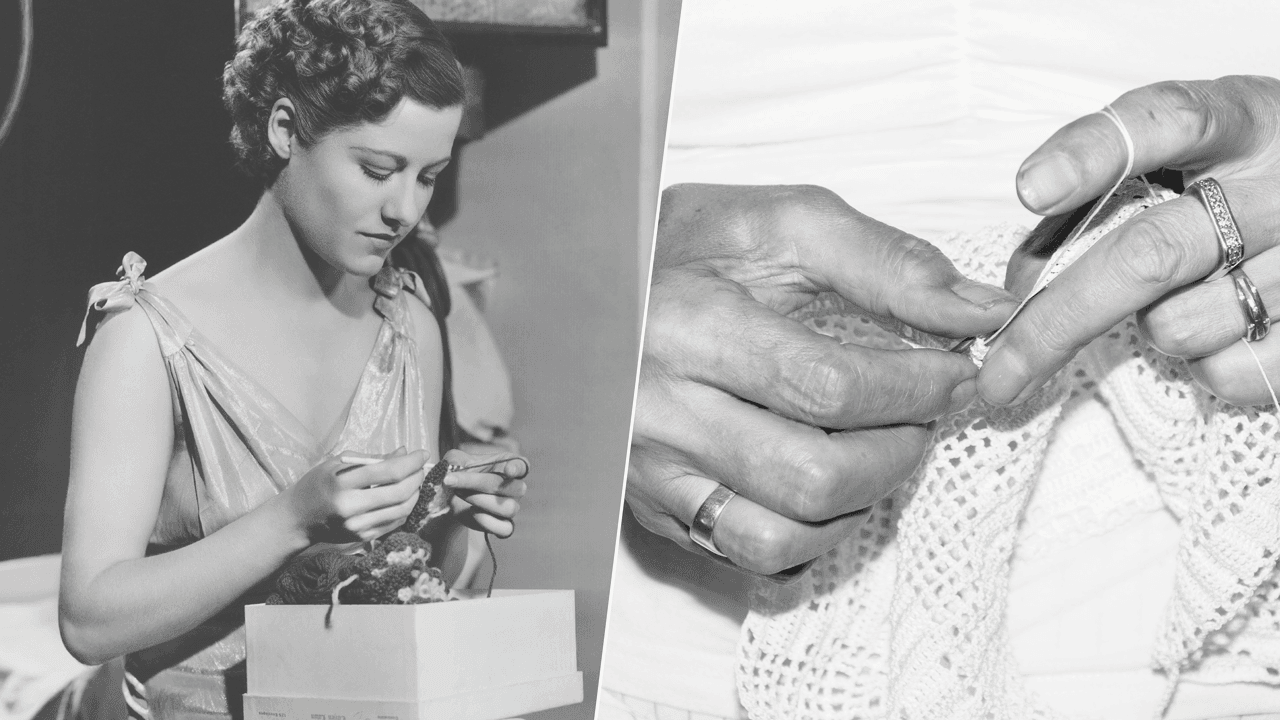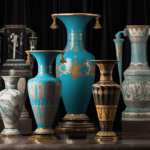Embark on a captivating journey through time to unravel the rich history of crochet. From its mysterious beginnings in ancient civilizations to its rise as a beloved craft in the Victorian era, we’ll delve into the fascinating evolution of this timeless art form. Explore the possible origins of crochet, the key figures and trends that shaped its development, and the enduring legacy that continues to inspire crafters today.
History of Crochet 1500 BC – 1820
While the exact origins of crochet remain shrouded in mystery, tantalizing clues suggest that people have been looping and knotting fibers together for millennia. Let’s journey back in time to explore the fascinating history of crochet from its ancient roots to its emergence as a recognized craft in the 19th century.
Way Back When: Ancient Hints of Crochet (1500 BC and Beyond)
Archaeological discoveries hint at the existence of crochet-like techniques in ancient civilizations. Fragments unearthed in Israel, potentially dating back to 6500 BC, bear a striking resemblance to slip-stitch crochet, suggesting that early cultures may have practiced similar crafts. These findings tantalize us with the possibility that crochet, or a precursor to it, was practiced far earlier than previously believed.
Crochet’s Precursors: Shepherd’s Knitting and Tambour Embroidery
As we move into the Middle Ages, we find intriguing parallels to crochet in various needlework traditions. Shepherd’s knitting, originating in Denmark, utilized a single needle to create a textured fabric, employing techniques that likely informed the development of crochet. Similarly, Chinese tambour embroidery, with its use of a hook to pull thread through fabric, presents another compelling link in the evolutionary chain of crochet.
Crochet Takes Center Stage (1820s)
The 1820s marked a pivotal moment in crochet history, with the craft emerging as a recognized and increasingly popular pastime. This era saw the first published crochet patterns, providing crafters with standardized instructions and fueling the spread of this versatile craft. The availability of affordable cotton yarn and readily accessible crochet hooks further contributed to the burgeoning popularity of crochet, making it a pastime accessible to people from all walks of life.
Cultural Influences on Crochet’s Rise
The surge in crochet’s popularity during the 1820s can be attributed, in part, to the societal changes sweeping through England at the time. As industrialization transformed society, women sought creative outlets and social connections. Crochet provided a fulfilling pastime, allowing women to express their creativity, socialize with fellow crafters, and even earn income by selling their handmade creations.
Early Crochet: Simplicity and Intricacy
Early crochet patterns, such as those featured in the Dutch magazine “Penélope” in 1824, showcased the remarkable artistry possible with basic stitches. These patterns, often utilizing simple stitch combinations, produced intricate designs and delicate embellishments, highlighting the skill and ingenuity of early crocheters.
This exploration of crochet’s early history offers a glimpse into the enduring human fascination with transforming yarn into beautiful and functional creations. While many questions about crochet’s origins remain unanswered, ongoing research continues to shed light on the fascinating journey of this beloved craft.
When was crochet first invented?
Pinpointing the exact moment crochet emerged is a bit like trying to find the end of a never-ending yarn tail! Evidence suggests that crochet-like techniques have been around for centuries, even millennia. However, modern crochet, as we know it, emerged in the early 19th century, with its roots entwined with ancient practices and evolving needlework traditions.
- Ancient Whispers of Crochet (1500 BC and Beyond): Archaeological digs have unveiled intriguing artifacts in places like Israel that suggest people might have been using crochet-like techniques as far back as 1500 BC. These findings hint at the existence of a rich, yet underexplored, history of looped fabric creation.
- Medieval Needlework: Setting the Stage for Crochet: Fast forward to the medieval period, and we find techniques like tambour embroidery and shepherd’s knitting flourishing. These crafts, with their use of hooks and looped stitches, likely played a significant role in laying the groundwork for crochet as we know it today.
- The 1820s: Crochet’s “Official” Debut: While earlier forms of crochet-like techniques existed, the 1820s is widely regarded as the birthdate of modern crochet. This period witnessed the first documented use of the word “crochet” and the emergence of the first known crochet pattern in 1823, published in the Dutch magazine Penélope.
- Factors Contributing to Crochet’s Rise: The mid-19th century saw a confluence of factors that propelled crochet into the spotlight. The increased availability of affordable cotton yarn and crochet hooks made the craft accessible to a wider population. Simultaneously, women’s magazines began featuring crochet patterns, further fueling its popularity and introducing new techniques and designs to eager crafters.
The story of crochet’s invention is an ongoing exploration, with researchers and textile enthusiasts continuing to uncover fascinating clues. While the exact origins may remain shrouded in some mystery, the enduring popularity of crochet speaks volumes about the timeless appeal of this versatile and creatively fulfilling craft.
What is the history of crochet in Egypt?
While concrete evidence remains elusive, crochet’s presence in ancient Egypt is hinted at through intriguing archaeological discoveries and the use of techniques closely related to modern crochet.
- Ancient Egyptian Tombs: Hints of Crochet’s Presence: The discovery of textile fragments resembling crocheted pieces within ancient Egyptian tombs suggests that this craft may have held cultural or spiritual significance. Some scholars speculate that these delicate creations, buried alongside the deceased, may have represented hopes for continuity or creativity in the afterlife.
- Tambour Embroidery: A Close Relative of Crochet: While definitive evidence of crochet in ancient Egypt is lacking, the use of tambour embroidery is well-documented. This technique, employing a hook to create looped stitches on fabric stretched taut over a frame, shares striking similarities with crochet and may have been a precursor to the craft we know today.
- A Legacy Passed Through Generations: Although the exact path crochet took from ancient times to its modern form remains a subject of ongoing research, its potential presence in ancient Egypt highlights the enduring nature of this craft. Crochet, in its various forms, has transcended time and cultures, leaving its mark on civilizations across the globe.
Did they crochet in the 18th century?
While the term “crochet” and the craft as we know it today didn’t gain widespread recognition until the early 19th century, the 18th century played a crucial role in setting the stage for crochet’s emergence. One technique, in particular, stands out as a significant precursor to modern crochet: tambour embroidery.
- Tambour Embroidery: Crochet’s Close Cousin: Imagine using a specialized hook to pull thread through fabric, creating delicate loops that form intricate patterns. That’s tambour embroidery, a popular needlework technique in the 18th century. Its similarity to crochet, both in tools and techniques, strongly suggests that it served as a significant influence on crochet’s development.
- Lacemaking Traditions: Further Influences: Beyond tambour embroidery, 18th-century lacemaking traditions also likely contributed to the evolution of crochet. The intricate designs and delicate stitches characteristic of lacemaking share a common thread with crochet, hinting at a shared lineage.
- Blurred Lines and Ongoing Research: While we often point to the 1820s as the “official” start of crochet, some experts suggest that crochet-like techniques, particularly those associated with lacemaking, might have existed even earlier. The history of textiles is an ongoing exploration, with new discoveries continually reshaping our understanding of how these crafts evolved.
In essence, while the 18th century might not have had crochet as we know it today, it was a time when techniques closely related to crochet flourished. These techniques, particularly tambour embroidery, laid the groundwork for the development of modern crochet, making the 18th century a pivotal period in the craft’s history.
What decade was crochet popular?
Crochet’s popularity has ebbed and flowed throughout history, experiencing periods of widespread acclaim and moments of relative obscurity. However, one decade stands out as a pivotal moment when crochet truly captured the hearts and minds of crafters: the 1820s.
- A Perfect Storm for Crochet’s Rise: In the 1820s, a confluence of factors converged to create the ideal environment for crochet to flourish. The availability of affordable cotton yarn and readily accessible crochet hooks made the craft more attainable for the masses. Simultaneously, women’s magazines began incorporating crochet patterns, providing readily available instructions and inspiring creativity.
- From Elite Hobby to Accessible Pastime: Before the 1820s, intricate needlework was often associated with the upper classes, who had the leisure time and resources to dedicate to these pursuits. However, the increased accessibility of materials and the emergence of readily available patterns democratized crochet, making it a beloved pastime for people from all walks of life.
- The Enduring Appeal of Handmade Crafts: Crochet’s popularity in the 1820s speaks to a timeless human desire to create. In an increasingly industrialized world, crochet provided a tangible connection to tradition, craftsmanship, and the satisfaction of creating something beautiful and useful by hand.
While crochet has experienced waves of popularity over the years, the 1820s remain a defining decade for the craft. It was during this time that crochet shed its image as an elite hobby and emerged as a widely embraced pastime, embraced by individuals from all societal strata who found joy in its versatility and creative potential.
Who is the mother of crochet?
While crochet has a rich and fascinating history, attributing its invention to a single individual is a bit like trying to find the very first loop in an intricately crocheted tapestry – nearly impossible! The craft likely evolved over centuries, influenced by various cultures and techniques.
- Ancient Roots and Whispers of Crochet: Some historians point to evidence of crochet-like techniques in ancient China, potentially dating back to 200 AD. Others suggest that similar needlework traditions might have existed around the Arabian Peninsula in the 700s. While we can’t definitively confirm these early instances as “crochet,” they highlight the widespread practice of looped fabric creation throughout history.
- 16th Century Europe: Laying the Foundation: In 16th century Europe, women in Italy and France utilized hooks and thread to create exquisite lace. While not quite the crochet we know today, these techniques demonstrate a clear progression toward the craft’s modern form.
- The 1820s: Modern Crochet Takes Shape: The 1820s in England witnessed a significant turning point in crochet’s history. This era saw the emergence of “slip-stitch crochet,” a technique that revolutionized the craft and allowed for the creation of the intricate and detailed designs we associate with modern crochet.
- Queen Victoria: Crochet’s Royal Advocate: No discussion of crochet’s popularity in the 19th century would be complete without mentioning Queen Victoria. A devoted crocheter herself, Queen Victoria’s fondness for the craft elevated its status and inspired countless women to pick up a hook and yarn.
- Crochet’s Global Journey: From its origins in Europe, crochet embarked on a global journey, spreading rapidly across continents and cultures. As cotton yarn and crochet hooks became more affordable, people from all walks of life embraced the craft, adapting it to their own traditions and creating a vibrant tapestry of crochet styles.
While we may never know the identity of the very first crocheter, crochet’s story is a testament to the collective creativity of countless individuals who, throughout history, have found joy and artistic expression in transforming yarn into beautiful and meaningful creations. This shared legacy continues to inspire today, as crocheters worldwide embrace the craft’s versatility and endless possibilities.
What is the first thing to crochet?
Congratulations on taking the plunge into the wonderful world of crochet! Choosing your first project can feel exciting and maybe a tad overwhelming with so many possibilities. Don’t worry; we’ll guide you towards a fantastic first project that will ignite your passion for this versatile craft.
While some might suggest starting with the quintessential granny square (a classic for a reason!), the best first crochet project is one that speaks to your interests and keeps you engaged.
Here’s a thought: instead of limiting yourself to the “simplest” option, why not browse patterns that genuinely excite you?
Consider these beginner-friendly projects:
| Project Idea | Skill Level | Why It’s Great for Beginners |
|---|---|---|
| Crochet Coasters | Beginner | Small, manageable, and perfect for practicing those fundamental stitches. |
| Scarf | Beginner | Learn to work in rows, try out different textures, and end up with a cozy accessory! |
| Granny Square | Beginner | The building block for countless projects! Explore color changes and see where your creativity takes you. |
| Simple Hat | Easy | A satisfying project that introduces you to shaping techniques. |
| Small Storage Basket | Easy | Learn to crochet in the round and create a practical piece for your home. |
Remember:
- It’s a journey, not a race! Embrace the process, and don’t be discouraged if your first project isn’t flawless. Practice makes progress!
- Choose joy! Select a project that excites you, and the learning process will be all the more enjoyable.
- Experiment! Don’t be afraid to try different yarns, colors, and patterns. Crochet is all about exploring your creativity!
Now, grab your hook, choose some yarn that speaks to you, and let’s get stitching! Your crochet journey awaits!
When did the crochet trend start?
Crochet, as a defined craft with a recognizable name, emerged in the early 19th century, experiencing a surge in popularity in the 1820s. However, its roots extend further back in time, intertwined with the evolution of various needlework techniques.
- Early 19th Century: Crochet’s Formal Debut: The 1820s marked a pivotal moment for crochet, witnessing the adoption of the term “crochet” itself, derived from the French word “croche” meaning “hook.” This period saw the publication of the first recognizable crochet patterns, most notably in the Dutch women’s magazine, Penélope.
- Influence of Earlier Techniques: Crochet didn’t appear out of thin air; it evolved from earlier techniques like tambour embroidery, an ancient Chinese craft using a hook to create looped stitches on fabric. Shepherd’s knitting, originating in Denmark, also contributed to crochet’s development with its use of a single needle to create a textured fabric.
- Lace-Making: A Key Inspiration: The origins of crochet are believed to be closely linked to lace-making practices, potentially dating as far back as 1500 BC. These early forms of lace-making, while distinct from modern crochet, likely employed similar tools and techniques, suggesting a shared ancestry.
- Ongoing Research and Discoveries: While we attribute crochet’s emergence to the early 19th century, ongoing research in textile history continues to reveal intriguing details about its origins. Scholars and enthusiasts are continually unearthing new evidence that might further illuminate crochet’s fascinating journey through time.
For those eager to delve deeper into the captivating history of crochet, the work of Lis Paludan, a renowned textile historian, offers valuable insights. Her article, “The Origin of Modern Crochet: Tambour Lace and Shepherd’s Knitting,” available online at JSTOR, is an excellent resource for further exploration.
How long have humans been crocheting?
Determining the precise moment humans began practicing crochet is like trying to find the very first strand in a massive ball of yarn – intricate and challenging! While pinpointing an exact timeline remains elusive, evidence suggests that people have been using crochet-like techniques for a significant period.
- Ancient Origins (1500 BC and Earlier): Archaeological findings hint at the existence of crochet-like techniques in ancient civilizations. Artifacts discovered in Israel, potentially dating back to 1500 BC, bear a striking resemblance to modern slip-stitch crochet, suggesting that these early cultures might have employed similar crafting methods.
- Emergence of Modern Crochet (Early 19th Century): While ancient civilizations likely practiced crochet-like techniques, the crochet we know and love today emerged in the early 19th century. The term “crochet” itself gained traction around the 1820s, coinciding with the publication of the first recognizable crochet patterns.
- Victorian Era: Crochet’s Golden Age: The Victorian era (1837-1901) witnessed a surge in crochet’s popularity. Queen Victoria herself was an avid crocheter, and her influence, combined with the increased availability of affordable materials and patterns, propelled crochet into the spotlight.
- From Lace to Everyday Items: Early crocheters focused on creating delicate lacework, but the craft’s versatility quickly became apparent. People started using crochet to fashion garments, blankets, and various household items, cementing its place as both a decorative and practical craft.
- Crochet’s Enduring Legacy: Today, crochet thrives as a beloved hobby worldwide. Its enduring appeal lies in its accessibility, versatility, and the inherent satisfaction of creating something beautiful and unique by hand. From intricate lacework to modern amigurumi, crochet continues to evolve, reflecting the creativity and ingenuity of each generation of crocheters.
While the precise timeline of crochet’s origins might remain somewhat shrouded in mystery, its enduring legacy is a testament to the enduring human desire for artistic expression and the timeless appeal of creating with yarn and a hook.
Was Crochet a Thing in the 70s?
Oh, you better believe crochet was the thing in the 1970s! It transcended its image as a “grandma” craft and became a symbol of counterculture, individuality, and creative expression.
- Handmade Revolution: The 70s was all about embracing handmade, unique items, rejecting mass production and conformity. Crochet fit right into this ethos, allowing people to express their personal style and create one-of-a-kind pieces.
- Groovy Vibes: Crochet designs from the 70s were bold, colorful, and often incorporated psychedelic patterns. Granny squares, in all their colorful glory, were particularly popular, making appearances in everything from vests and shawls to blankets and wall hangings.
- Fashion Forward: The free-flowing, bohemian fashion trends of the 70s were a perfect match for crochet. Think long, flowing crocheted vests, macramé bags slung across shoulders, and even crocheted bikinis! Crochet added a touch of handmade charm and individuality to the decade’s eclectic style.
- A Craft for Everyone: Crochet in the 70s wasn’t just limited to one generation. Young and old embraced the craft, finding common ground in its creativity and accessibility. Pattern books and magazines were filled with innovative designs, inspiring a new generation of crocheters.
- Enduring Legacy: The crochet designs of the 70s remain popular today, sought after for their vintage charm and nostalgic appeal. They remind us of a time when handmade was king and individual expression was celebrated.
So, yes, crochet was definitely “a thing” in the 70s – a vibrant and integral part of the decade’s cultural tapestry. It embodied the era’s spirit of creativity, individuality, and the joy of crafting something unique with your own two hands.
Did the Vikings Crochet?
We often picture Vikings as skilled craftspeople, adept at woodworking, metalwork, and creating intricate textiles. But did their impressive repertoire include crochet? Well, here’s the catch:
- Crochet’s Timeline: Crochet, as we know it today, emerged in the 19th century, long after the Viking age. The earliest identified crochet patterns date back to the 1820s, while the Vikings sailed the seas and raided coastlines from the 8th to the 11th centuries.
- Nålbinding: The Viking Way of Needlework: While Vikings might not have crocheted, they were masters of a technique called nålbinding. This ancient craft involves using a single needle to create a knotted fabric, similar in appearance to knitting but distinct in its execution.
- Tools and Techniques: Nålbinding, unlike crochet, doesn’t use a hooked needle. Presenting a Viking with a crochet hook would likely have resulted in confusion rather than a crafting session!
- A Realm of Possibilities: However, the absence of concrete evidence doesn’t completely rule out the possibility that Vikings, known for their resourcefulness and adaptability, might have experimented with techniques that share similarities with crochet. After all, the history of textiles is constantly evolving, with new discoveries challenging existing assumptions.
While we can confidently say that Vikings didn’t practice crochet as we know it today, it’s fun to imagine these skilled craftspeople experimenting with loops and yarn, potentially developing techniques that foreshadowed the emergence of this beloved craft centuries later. The world of textiles is full of intriguing possibilities and undiscovered histories, leaving room for speculation and excitement about what we might yet uncover.

















3 thoughts on “Unraveling the History of Crochet from 1500 BC to the 19th Century”
Comments are closed.